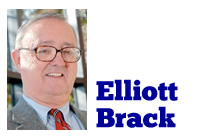By Elliott Brack, editor and publisher | Here we are nearly a year away from the national election in November 2016. The year 2015 has been a boisterous pre-election year at least for the Republican candidates, while the quieter Democrats have honed their list of candidates to three people.
 At one time the Republicans had 16 people vying for the spotlight, now 12 remain. That’s still a lot. And the polls show two people who have never been elected to political office, Dr. Ben Carson and Donald Trump, top the list for the GOP.
At one time the Republicans had 16 people vying for the spotlight, now 12 remain. That’s still a lot. And the polls show two people who have never been elected to political office, Dr. Ben Carson and Donald Trump, top the list for the GOP.
Somehow, it appears to us that neither of the two GOP candidates will be the eventual nominee, though, of course, you never know. Somehow, we think that the old-line Republican leaders within the party will make the final determination of who wins at the convention next year. And that the winner will come out strong, and put up a good fight for the office.
While on the Democratic side, we somehow are not convinced yet that Hillary Clinton will win the nomination, though she is showing more strength than ever before. Only time will tell who the nominees are for either party; no one seems to have it absolutely sewn up.
Two factors in this election cycle may determine who the next president will be. But these factors are not absolute.
First, an April release from the well-respected Pew Research Center, which concentrates on U.S. politics and policy, shows a deep divide in party affiliation in the nation. The totals who lean Democratic is 48 percent, while the number of people who lean Republican is 39 percent, a nine percent difference. Looking at that, it would mean that the Democrats enter the election primary with a definite advantage.
Now to complicate this element: currently there are 31 Republican governors, and only 18 Democrat governors, and one independent. (Bill Walker of Alaska is the independent). Adding to that, an election in Kentucky recently to take office in 2017 will make it 32 Republican governors, and 17 Democrats.
Isn’t that strange? While people lean Democratic nationally, according to Pew, when they go to the polls to vote for their state’s leading official, they elect Republicans. Yep, that complicates matters.
The second factor that also complicates the upcoming presidential election is that the share of people who consider themselves political independents continues to rise. These people may vote either way. Pew says in their 2015 poll that there are now 39 percent who consider themselves Independents, 32 percent who are Democrats and 23 percent who are Republicans.
Among people who claim a party affiliation, there is still that nine percent gap between Democrats and Republicans. So no matter who the Republicans or Democrats nominate, it may be the Independents who decide the election.
The two major parties will, therefore, do their best to attract these Independent voters. You may see all sorts of slants to the two party platforms to attract these Independents. Yet every time either of the two parties hedge their platform statements to lean one way or the other, they could be losing votes from the Independents. (You figure both party’s regulars will vote their leanings come what may.)
It sure makes the run-up to the election, at this point, mighty interesting.










Follow Us